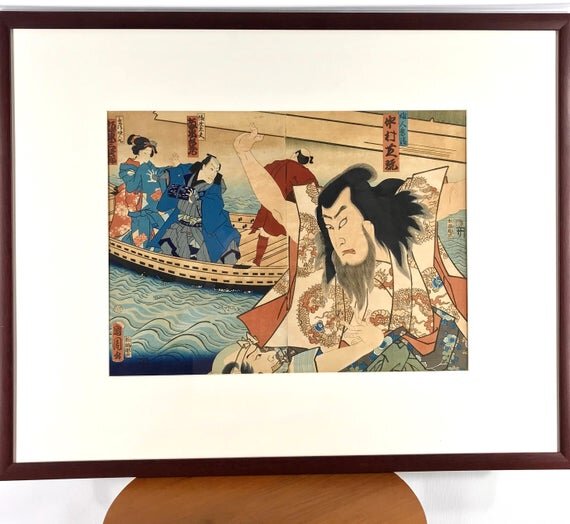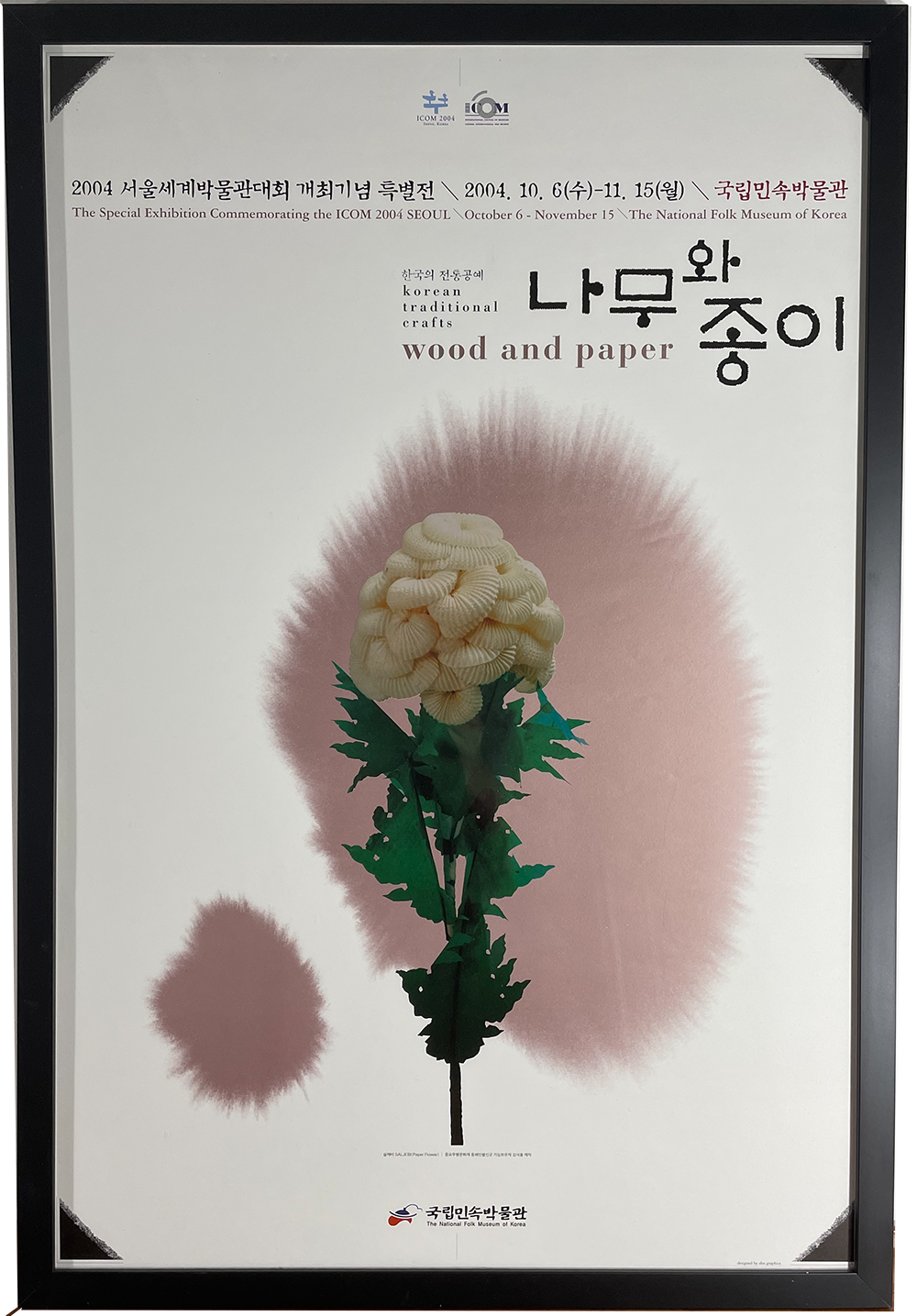"Gathering Logs" Hyman Warsager, serigraph, WPA New York 1935
Rare serigraph produced during the aggressive Works Project Administration of the 1930s that provided employment to workers and artists during the Depression.
“Gathering Logs” serigraph is in a new frame with archival matte and backing. The frame measures 19” x 21” and the visible image is 12.5” x 14.5”.
Hyman Joseph Warsager was born in New York City on June 23, 1909. He studied at the Hartford Art School, the Metropolitan Museum of Art, Pratt Institute of Art, the Grand Central School and the American Artists School. Warsager joined the graphic division of the WPA/FAP in 1935, during the Depression, working in the new medium of “serigraphy” as well as etching and lithography. In his 1936 essay "Graphic Techniques in Progress" Warsager described silk screen as "'the most startling contribution to color prints' because of the economy, ease and diverse possibilities of the process." He also worked as an illustrator, contributing a number of images to “The New Masses”.
He was politically active, speaking out about social injustice, poverty and racism. Warsager was a member of the John Reed Club. The club was named after the journalist who founded the American Communist Party in 1929. The club had 30 branches in major cities across the country, and sponsored art exhibitions, art classes, and political discussions.
He was also one of the 45 artists whose work was included in an exhibition at the ACA Gallery in Greenwich Village in 1935 titled, The Struggle for Negro Rights. Despite his leftist stances Warsager, who was Jewish, served in the US Military during WWII between July of 1942 through July of 1945.
His work is included in the collections of the Brooklyn Museum, the San Francisco Art Academy, and Wesleyan University. In his later years he experimented with abstract printmaking, even using a method of printing on a plaster matrix, a technique that had been used at Atelier 17 in both Paris and New York. Hyman J.
Warsager died in the Bronx, New York on November 27, 1974.
The Works Progress Administration or WPA was launched in 1935 by President Franklin D. Roosevelt to provide employment during the depression. Under the WPA there were new roads, dams and other public works project. It also put artists, actors, writers and musicians to work contributing their share to the cultural development of the nation. Artists were paid by the hour, on average, $26 a week and many were given their professional start by the WPA. In 1938 the actor Burgess Meredith credited the WPA with promoting new art. "Although the WPA art project was primarily designed to give employment to unemployed artists, the result has been the establishment of the beginning of a vital art movement which is unparalleled in history."
In excellent condition, has been housed in a drawer for many years. From the estate collection of Arthur Raymond Young, American artist and educator.
New archival frame. Print can be sold without the frame. Contact us to discuss.
NOTE: This requires a custom shipping quote. Please contact us before purchase.
Rare serigraph produced during the aggressive Works Project Administration of the 1930s that provided employment to workers and artists during the Depression.
“Gathering Logs” serigraph is in a new frame with archival matte and backing. The frame measures 19” x 21” and the visible image is 12.5” x 14.5”.
Hyman Joseph Warsager was born in New York City on June 23, 1909. He studied at the Hartford Art School, the Metropolitan Museum of Art, Pratt Institute of Art, the Grand Central School and the American Artists School. Warsager joined the graphic division of the WPA/FAP in 1935, during the Depression, working in the new medium of “serigraphy” as well as etching and lithography. In his 1936 essay "Graphic Techniques in Progress" Warsager described silk screen as "'the most startling contribution to color prints' because of the economy, ease and diverse possibilities of the process." He also worked as an illustrator, contributing a number of images to “The New Masses”.
He was politically active, speaking out about social injustice, poverty and racism. Warsager was a member of the John Reed Club. The club was named after the journalist who founded the American Communist Party in 1929. The club had 30 branches in major cities across the country, and sponsored art exhibitions, art classes, and political discussions.
He was also one of the 45 artists whose work was included in an exhibition at the ACA Gallery in Greenwich Village in 1935 titled, The Struggle for Negro Rights. Despite his leftist stances Warsager, who was Jewish, served in the US Military during WWII between July of 1942 through July of 1945.
His work is included in the collections of the Brooklyn Museum, the San Francisco Art Academy, and Wesleyan University. In his later years he experimented with abstract printmaking, even using a method of printing on a plaster matrix, a technique that had been used at Atelier 17 in both Paris and New York. Hyman J.
Warsager died in the Bronx, New York on November 27, 1974.
The Works Progress Administration or WPA was launched in 1935 by President Franklin D. Roosevelt to provide employment during the depression. Under the WPA there were new roads, dams and other public works project. It also put artists, actors, writers and musicians to work contributing their share to the cultural development of the nation. Artists were paid by the hour, on average, $26 a week and many were given their professional start by the WPA. In 1938 the actor Burgess Meredith credited the WPA with promoting new art. "Although the WPA art project was primarily designed to give employment to unemployed artists, the result has been the establishment of the beginning of a vital art movement which is unparalleled in history."
In excellent condition, has been housed in a drawer for many years. From the estate collection of Arthur Raymond Young, American artist and educator.
New archival frame. Print can be sold without the frame. Contact us to discuss.
NOTE: This requires a custom shipping quote. Please contact us before purchase.
Rare serigraph produced during the aggressive Works Project Administration of the 1930s that provided employment to workers and artists during the Depression.
“Gathering Logs” serigraph is in a new frame with archival matte and backing. The frame measures 19” x 21” and the visible image is 12.5” x 14.5”.
Hyman Joseph Warsager was born in New York City on June 23, 1909. He studied at the Hartford Art School, the Metropolitan Museum of Art, Pratt Institute of Art, the Grand Central School and the American Artists School. Warsager joined the graphic division of the WPA/FAP in 1935, during the Depression, working in the new medium of “serigraphy” as well as etching and lithography. In his 1936 essay "Graphic Techniques in Progress" Warsager described silk screen as "'the most startling contribution to color prints' because of the economy, ease and diverse possibilities of the process." He also worked as an illustrator, contributing a number of images to “The New Masses”.
He was politically active, speaking out about social injustice, poverty and racism. Warsager was a member of the John Reed Club. The club was named after the journalist who founded the American Communist Party in 1929. The club had 30 branches in major cities across the country, and sponsored art exhibitions, art classes, and political discussions.
He was also one of the 45 artists whose work was included in an exhibition at the ACA Gallery in Greenwich Village in 1935 titled, The Struggle for Negro Rights. Despite his leftist stances Warsager, who was Jewish, served in the US Military during WWII between July of 1942 through July of 1945.
His work is included in the collections of the Brooklyn Museum, the San Francisco Art Academy, and Wesleyan University. In his later years he experimented with abstract printmaking, even using a method of printing on a plaster matrix, a technique that had been used at Atelier 17 in both Paris and New York. Hyman J.
Warsager died in the Bronx, New York on November 27, 1974.
The Works Progress Administration or WPA was launched in 1935 by President Franklin D. Roosevelt to provide employment during the depression. Under the WPA there were new roads, dams and other public works project. It also put artists, actors, writers and musicians to work contributing their share to the cultural development of the nation. Artists were paid by the hour, on average, $26 a week and many were given their professional start by the WPA. In 1938 the actor Burgess Meredith credited the WPA with promoting new art. "Although the WPA art project was primarily designed to give employment to unemployed artists, the result has been the establishment of the beginning of a vital art movement which is unparalleled in history."
In excellent condition, has been housed in a drawer for many years. From the estate collection of Arthur Raymond Young, American artist and educator.
New archival frame. Print can be sold without the frame. Contact us to discuss.
NOTE: This requires a custom shipping quote. Please contact us before purchase.




















